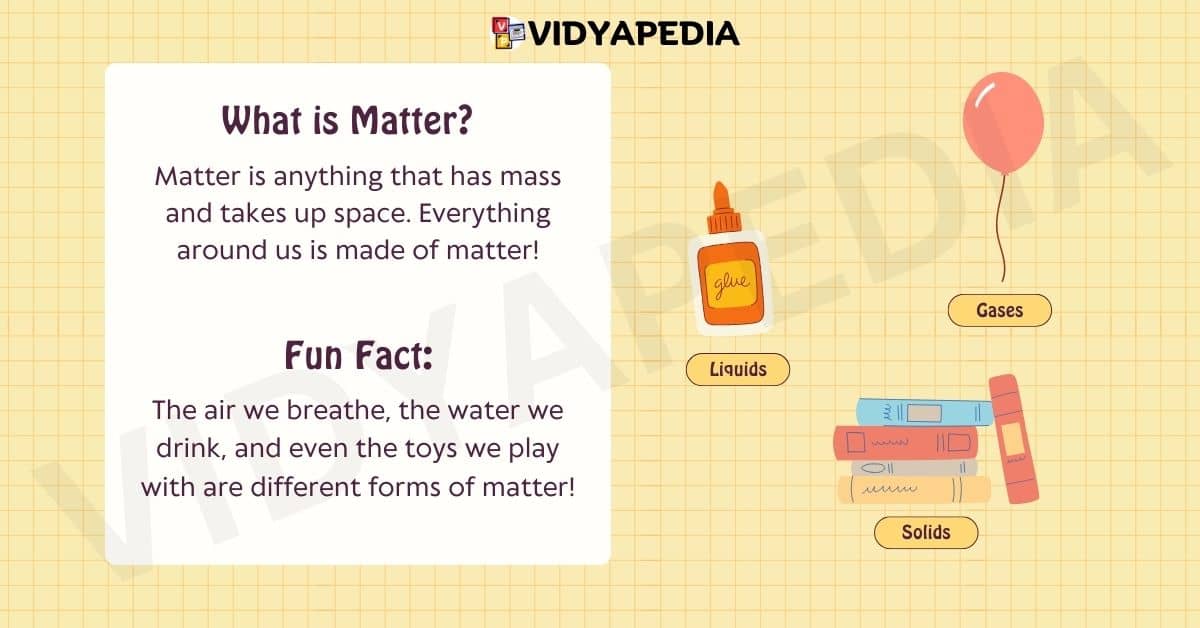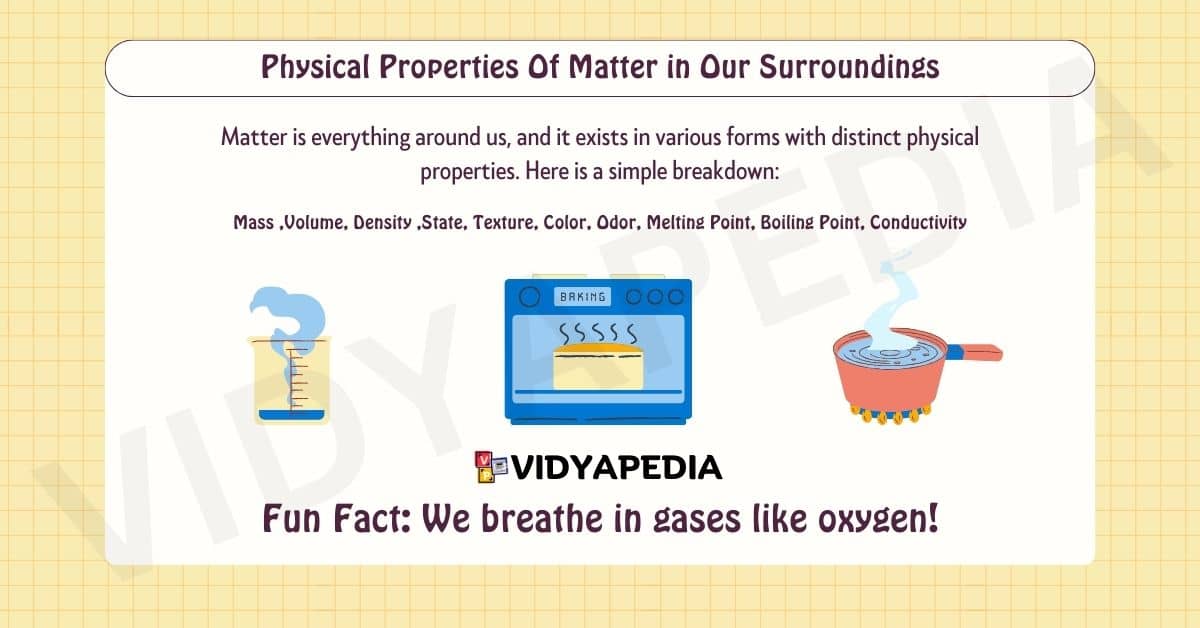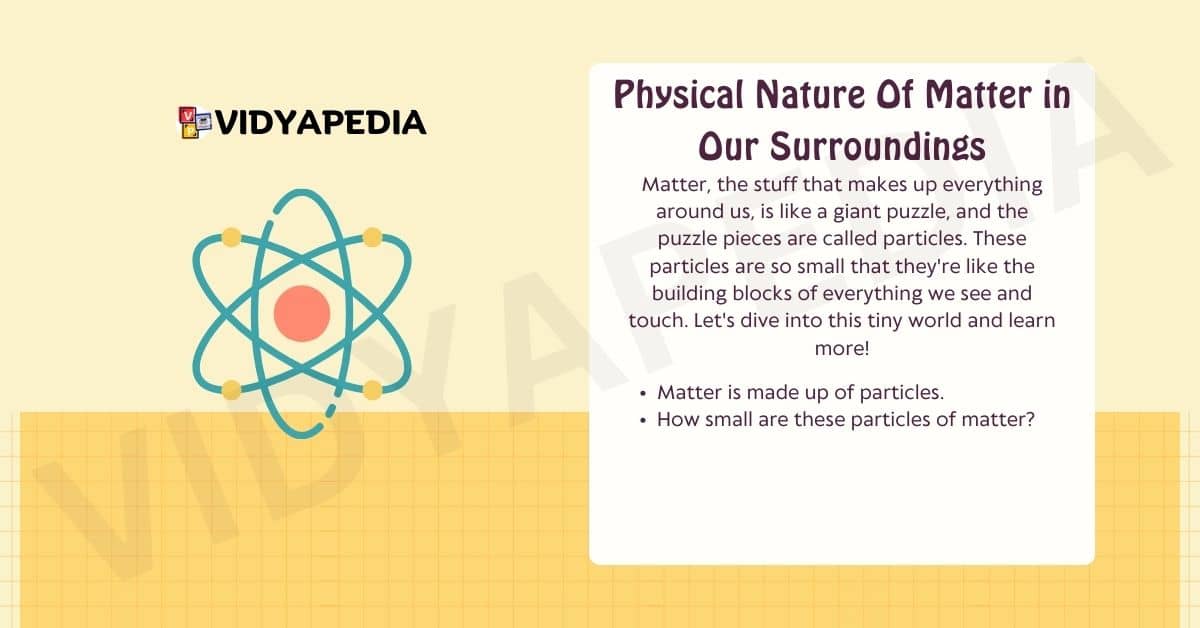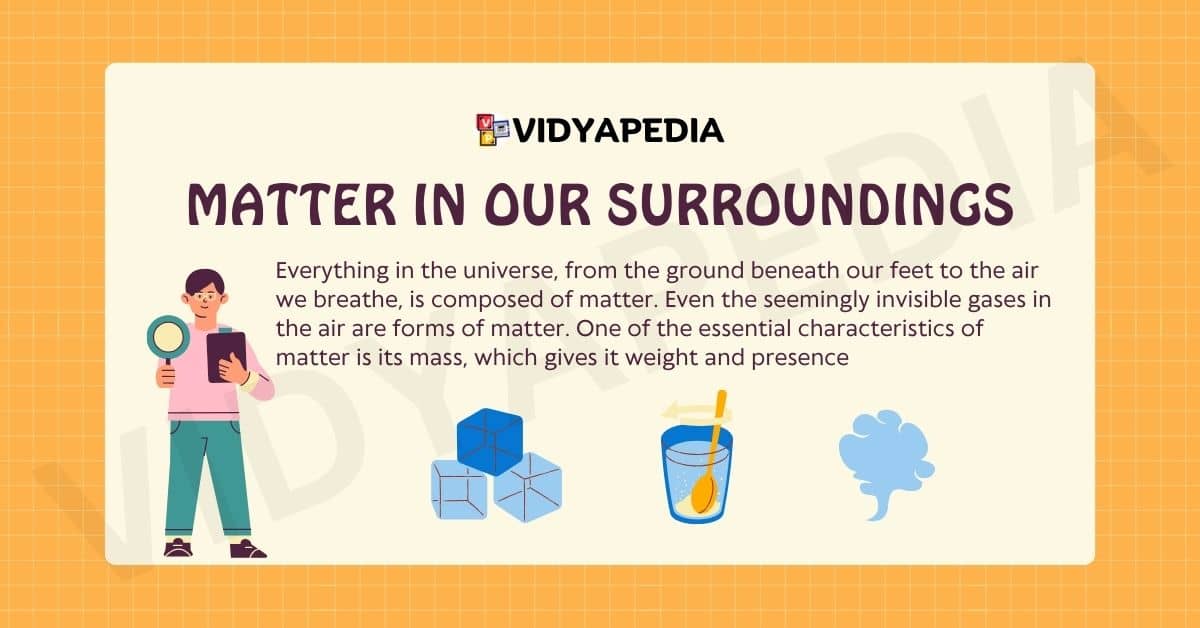“Matter in Our Surroundings” is a science topic that explores the physical properties and states of matter, emphasizing how substances exist in our everyday environment. Students learn about solids, liquids, and gases, as well as the state changes they undergo. The study involves understanding concepts like melting, boiling, and sublimation, providing a foundation for comprehending the behaviour of matter in different conditions.
Everything in the universe, from the ground beneath our feet to the air we breathe, is composed of matter. Even the seemingly invisible gases in the air are forms of matter. One of the essential characteristics of matter is its mass, which gives it weight and presence. Furthermore, matter takes up space, filling our surroundings with various solids, liquids, and gases. Understanding these basic properties helps unravel the intricacies of the diverse materials that constitute our everyday environment.

What Is matter?
Consider matter as the unique substance that makes up everything. When we breathe, we take in air, which is likewise composed of substance.
Matter is everywhere
Matter exists in many shapes and sizes. It exists in the clouds in the sky, the land we see, the vegetation, and all of the animals. Each of these is analogous to a different material recipe.
Fundamental Existance Of Matter
Matter is fundamental to our existence. Everything, including the air we breathe, the solid earth beneath our feet, the towering trees, and the smallest water droplet, is made out of matter. The act of breathing ties us to the substance that composes the atmosphere around us.
Matter’s Ubiquity
Matter presents itself in numerous ways throughout our environment. The majestic clouds in the sky, the sweeping landscapes, the intricate structures of plants, and the diverse assortment of animals all indicate a unique arrangement of matter.
Matter Has Weight
Matter does not just exist; it has weight. Consider the large planets in the sky or the light breeze you feel; both have this thing called “mass.” Even you and your pet dog are composed of substance.
Cool’s Features
What’s great is that matter may vary in texture; some can be hard, like your desk, while others are soft, like a cushion. It might be thick or thin, which is what makes our surroundings so interesting!
Sorting Out Shift
Think of matter as a large family. We can categorize objects based on how they feel, how heavy they are, and what they seem like. It’s like playing a game where you group objects together based on their unique characteristics.
Physical Properties Of Matter in Our Surroundings

Matter is everything around us, and it exists in various forms with distinct physical properties. Here is a simple breakdown:
- Mass
- Volume
- Density
- State
- Texture
- Color
- Odor
- Melting Point
- Boiling Point
- Conductivity
Mass is the amount of “stuff” in a thing. A heavier backpack has a higher mass than a lighter one.
Volume refers to the amount of space an object occupies. A full glass of water has more volume than an empty one.
Density refers to how closely packed the substance is. Dense objects, such as solid rocks, contain more substance in the same amount of area.
State: Whether it is solid, liquid, or gaseous. Ice is a solid, while water is a liquid and steam is a gas.
Texture describes how something feels. The texture of matter can be described as smooth, rough, or soft.
Color is the visual appearance of an object. Apples are red, and the sky is blue; colour is a property of matter.
Odour describes how something smells. Fresh flowers have a lovely odour, whereas rubbish may have an unpleasant one.
Melting point: The temperature at which a solid converts to a liquid. When heated, ice melts and turns into water.
Boiling Point: The temperature at which a liquid converts to a gas. When heat is applied to water, it boils and produces steam.
Electrical conductivity is the ability to conduct heat or electricity. Metals, such as copper, are very conductive.
Read About Robotics🤖🤖
Physical Nature Of Matter in Our Surroundings

Matter, the stuff that makes up everything around us, is like a giant puzzle, and the puzzle pieces are called particles. These particles are so small that they’re like the building blocks of everything we see and touch. Let’s dive into this tiny world and learn more!
- Matter is made up of particles.
- How small are these particles of matter?
Matter is made up of particles.
Imagine your favourite toy, a book, or even the air you breathe. Now, think of them as made up of teeny-tiny pieces called particles. These particles are like invisible workers that come together to create everything. So, whether it’s a bouncy ball or a crunchy apple, it’s all thanks to these little building blocks doing their job.
How small are these particles of matter?
Okay, now let’s talk about small—like really, really small. Think of the tiniest thing you can imagine, like a dot. Now, break that dot into even smaller dots, and guess what? Those are the particles! They’re so tiny that even the smallest speck you can see is like a whole team of these particles hanging out. To discover this microscopic world, we’d need a super-duper microscope—a special tool to peek into the incredible world of these minuscule building blocks. It’s like having a secret entrance to a realm of the smallest stuff that makes our big world possible!
Frequently Asked Questions (FAQ)
Q1: Why do we study “Matter in Our World”?
We study it to understand the cool stuff around us and how things like toys, air, and even pizza are made!
Q2: Why is matter important for us?
Matter is the special stuff that makes everything, from the ground to the air. It’s like the invisible building blocks of our world
Q3: What’s cool about matter?
Matter can be hard, soft, or even thin – making our world interesting! It’s like having different textures in a giant puzzle.
Q4: How do we group things in matter?
We group things by how they feel, how heavy they are, and what they look like. It’s like sorting objects based on their unique features.
Q5: What are the main properties of matter?
Matter has properties like mass (how heavy), volume (how much space), and even state (solid, liquid, gas).
Q6: Why is matter everywhere?
Matter is in everything – from clouds in the sky to plants and animals. It’s like a big family with lots of different members.
Q7: How small are the building blocks of matter?
The building blocks, called particles, are super tiny – even smaller than the smallest dot you can imagine!
Q8: Why is mass important for matter?
Mass tells us how much “stuff” is in something – like a heavy backpack having more mass than a light one.
Q9: How does matter change its state?
Matter changes from solid to liquid (melting) and liquid to gas (boiling) when we add heat. It’s like a magical transformation in the world of matter!


